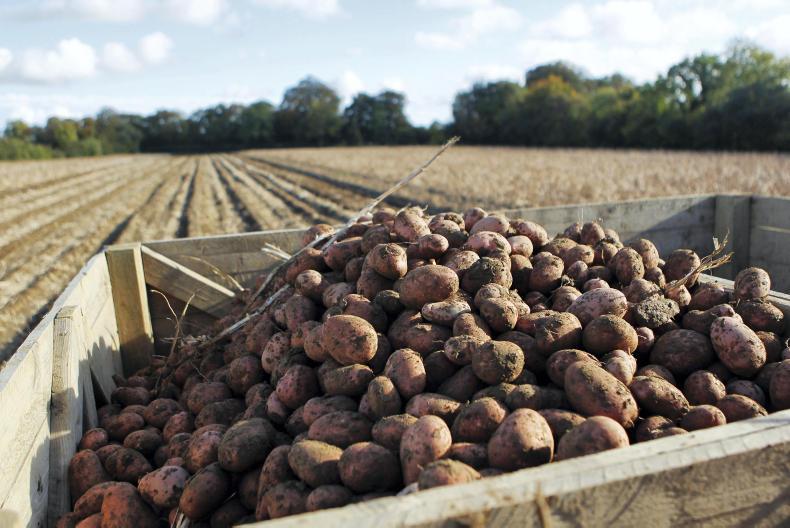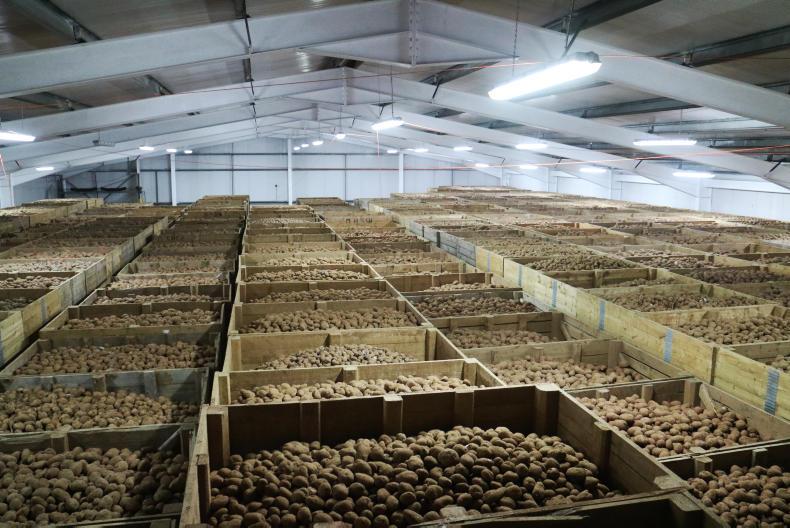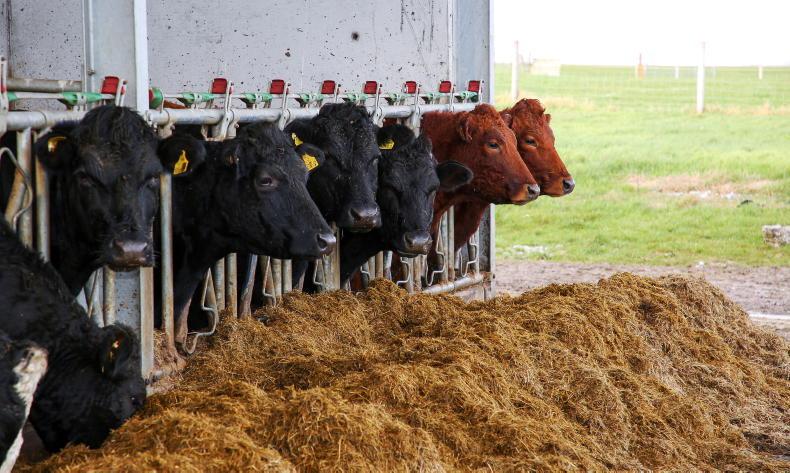Potato farmers will be all too aware that they will lose CIPC in the very near future. This active, also known as chlorpropham, has been important as a sprout suppressant in potatoes for decades, especially for processing varieties. It has been under review in Europe since 2015 and the prolonged period of evaluation quickly sent a signal to the market to be fearful about its continued availability. Eventually it was revoked in that review process and was not reregistered.
The beginning of the end for products containing CIPC has been set at 8 January 2020 for all member states. This means that all those who hold an authorisation for the registration cannot sell this active for distribution from that date. The next crucial date is that sales in Ireland must finish and it must be removed from the shelves of distributors by 8 July. And for those with potatoes in store, the last official use date is 8 October 2020.
The loss of CIPC initiated two big challenges. How will sprouting be prevented in processing potatoes in future and will new residue levels be set which will challenge potatoes harvested in the future that will be stored in existing stores?
The loss of CIPC represents a real threat to those involved in potato storage. While individual varieties will vary somewhat in the duration of their natural dormancy, all varieties will inevitably sprout in store once ambient temperatures increase in spring and hence the necessity for sprout suppressing agents.

This new product can be used to stop sprouting crops but this should not be necessary when management is good. \Donal O' Leary
While it remains available for potatoes harvested in 2019, there is a real need for growers and industry to find alternatives that work satisfactorily in our conditions. At a seminar organised by Haggard Stores last September, Adrian Briddon from the AHDB’s Sutton Bridge crop storage research centre outlined the challenge which the loss of CIPC presents.
He spoke about possible alternative approaches for sprout retardation and mentioned products like maleic hydrazide, spearmint, ethylene, orange oil, the volatile oily liquid 3-decen-2-one (SmartBlock™) and 1,4 Dimethylnaphthalene. Adrian said some of these show quite poor effects, while others work moderately well in a sequence with maleic hydrazide. However, the latter active is the one that offers by far the best alternative.
Some of the focus of the work at Sutton Bridge is attempting to understand the reasoning for the variability associated with the performance of maleic hydrazide. If this can be better understood to minimise its performance variability as a foliar treatment, it may result in the improved efficiency of some non-chemical treatments for the future. Adrian said the long-term objective is to find a non-chemical means of minimising sprouting.
The active 1,4 Dimethylnaphthalene is not new, but it is new to this part of the world. It has been used in the US for more than 20 years but it does not give season-long control from a single treatment. However, for the moment this is seen as by far the most successful alternative to replace CIPC. But it requires a different approach to sprouting management than was the case with CIPC and for this reason growers should begin to try it ahead of a likely dependence next year.
Where CIPC is used, the active remains on the tubers and continues to prevent sprouting. For this same reason it must be kept away from seed crops due to its persistence. The situation with 1,4 Dimethylnaphthalene (DMN) is quite different in that its effect will wear off and continued control will depend on follow-up treatments.
However, knowing and understanding the impact of natural variety dormancy is important here and this knowledge can be used to decrease the amount of chemical required to prevent sprouting.
Stephen McCabe of Haggard Stores said that DMN was registered for use in Ireland in October 2018 under the trade name 1,4Sight. This allowed for a very limited use last year to gain experience with the product and this was quite favourable. The product works by suppressing the genes associated with growth but the ability to grow returns when the chemical impact wears off. Hence the need for re-treating and why it can be used around seed crops.
The spec sheet specifies a maximum single-dose rate of 20ml/t and a maximum usage on a crop of 120ml per season. The process of application is very important. The product is relatively volatile and so it is important that stores be relatively well sealed to prevent excessive loss in airflow.

Potato tubers need to be dry in store before being treated with DMN.
Steven told us that a 1,400t store had been treated with DMN last year and the treatments were described as producing modest performance following five applications at around 30-day intervals. However, he stated that the high number of treatments was due to a leaky store and this was improved mid-season. In the same store it is expected that fewer treatments will give much better overall control this season.
Treat early
The general advice is that the first treatment should be made to all crops as soon as possible after they go into store. But it is important to have that store full when treating and to have the tubers dry and largely free of soil.
Treatment is done using a special electric fogging device to get the required atomisation for distribution within the store space and the earlier it is done in the life of a tuber the better. Temperatures must be above 5°C at application. Treatment takes about 40 minutes per 500t at full rate and the cost is approximately €4/t at full rate.
Air movement
Stephen said leaky stores require higher application rates and more frequent treatment. Because the active is volatile, the more of the total air space that is filled by the crop, the more efficient any application will be. It is also important to have the temperature equalised across the air in the store and the different elements of the store such as metal work, ducting, concrete etc. If this is not the case, condensation can result and this can be a problem.

Gentle ventilation is important during the application process and stores need to be well sealed to prevent loss of the active in air flow.
During the application process, the fans in the store should be run at about 30% capacity to circulate the fog around the sealed store. When application is complete, continue the circulation for about 20 minutes and then turn off the fans for 48 hours to allow everything to settle.
The crops must be continually inspected in store and a follow-up application should be applied when the eyes are blinking (a light colour develops around the eyes).
Because stores can take a long time to fill, the use of maleic hydrazide in the crop is generally seen as positive.
Experiences and recommendations
One crop treated last year had sprouts present at the time of treatment. Stephen said the DMN did a good job but that it is slow as the growing sprouts die back from the tips and turn black. Basically the tuber stops feeding the sprout following treatment and so the sprout dies back rather than being killed.
Stephen pointed to the need for a change in attitude for DMN versus CIPC. He emphasised that:
Treatment should be done as soon as possible after drying.DMN has no impact on the tuber curing process.The temperature at application must be above 5°C. Hot fog atomisation is essential to produce the small particles.Stores should have low internal ventilation and minimal leakage.Leave a treated store for 48 hours with no ventilation post-treatment.The availability of 1,4Sight (DMN) is good news for potato producers as an alternative to CIPC to suppress sprouting. However, a new challenge is also emerging as a consequence of CIPC being discontinued. As stated previously, CIPC is effective because it hangs around for a long time.
Like all registered chemicals, every active has an official maximum residue limit (MRL) set to control its use and protect consumers. But when an active is removed from the market its MRL is automatically replaced by an LoQ – its limit of quantification or limit of detection. This tends to be 0.01 parts per million (ppm) which is very low.
The problem for CIPC is that potatoes that go into store, even years after CIPC was last used, will pick up traces of CIPC and may exceed this LoQ. So officialdom is looking at what operational limit may be workable in the short and medium to long-term to reflect this background risk.
Adrian Briddon said LoQs are used to detect and deter unauthorised use of an active after it is no longer registered for use in the EU. The fact that we know that stores are ‘contaminated’ following the use of CIPC in the past alerts authorities to the potential risk and so authorities are now examining the possibility of a temporary MRL, possibly set around 0.5ppm.
Research conducted at AHDB indicated that the average level found in crops and stores not treated with CIPC was 0.052ppm and these crops would fail despite not having been treated. Indeed, Adrian said the highest value found in this sampling was 0.36ppm and that would be a definite fail.
Sources of contamination
This testing and sampling was done across a range of storage systems and across stores in which CIPC had not been used for a different number of years. The background contamination levels will reduce with time but this could take quite a number of years, especially where the active has become embedded in the concrete structures in the store.
Boxes are obviously a potential source of contamination once they have been used in stores that were treated with CIPC. However, Adrian said CIPC longevity is significantly reduced when it is exposed to light and the other elements. So he expects that boxes will not be a major source as these generally get left out in the elements for periods when stores are being unloaded.
The target of this research is to develop best practice for stores when CIPC is discontinued. It is essential to know the persistence level of this potential problem and what, if anything, can be done to speed up its degradation within stores.
Stephen stated the use of DMN can actually help to volatilise any CIPC on fixtures in a store. This will obviously act to increase CIPC levels in that crop of tubers – hence the concerns with regard to using an LoQ. However, we must also ask if the increasing use of DMN will accelerate the degradation of CIPC which will linger within potato stores for years following its use.
Main points
It looks like 1,4Sight can provide a good alternative to CIPC as a sprout suppressant.As well as being a new active, the use of DMN will also require a change of mind-set for its successful use.Early application tends to reduce overall treatment cost.The automatic implementation of an LoQ for CIPC will lead to problems in meeting this background residue limit.
Potato farmers will be all too aware that they will lose CIPC in the very near future. This active, also known as chlorpropham, has been important as a sprout suppressant in potatoes for decades, especially for processing varieties. It has been under review in Europe since 2015 and the prolonged period of evaluation quickly sent a signal to the market to be fearful about its continued availability. Eventually it was revoked in that review process and was not reregistered.
The beginning of the end for products containing CIPC has been set at 8 January 2020 for all member states. This means that all those who hold an authorisation for the registration cannot sell this active for distribution from that date. The next crucial date is that sales in Ireland must finish and it must be removed from the shelves of distributors by 8 July. And for those with potatoes in store, the last official use date is 8 October 2020.
The loss of CIPC initiated two big challenges. How will sprouting be prevented in processing potatoes in future and will new residue levels be set which will challenge potatoes harvested in the future that will be stored in existing stores?
The loss of CIPC represents a real threat to those involved in potato storage. While individual varieties will vary somewhat in the duration of their natural dormancy, all varieties will inevitably sprout in store once ambient temperatures increase in spring and hence the necessity for sprout suppressing agents.

This new product can be used to stop sprouting crops but this should not be necessary when management is good. \Donal O' Leary
While it remains available for potatoes harvested in 2019, there is a real need for growers and industry to find alternatives that work satisfactorily in our conditions. At a seminar organised by Haggard Stores last September, Adrian Briddon from the AHDB’s Sutton Bridge crop storage research centre outlined the challenge which the loss of CIPC presents.
He spoke about possible alternative approaches for sprout retardation and mentioned products like maleic hydrazide, spearmint, ethylene, orange oil, the volatile oily liquid 3-decen-2-one (SmartBlock™) and 1,4 Dimethylnaphthalene. Adrian said some of these show quite poor effects, while others work moderately well in a sequence with maleic hydrazide. However, the latter active is the one that offers by far the best alternative.
Some of the focus of the work at Sutton Bridge is attempting to understand the reasoning for the variability associated with the performance of maleic hydrazide. If this can be better understood to minimise its performance variability as a foliar treatment, it may result in the improved efficiency of some non-chemical treatments for the future. Adrian said the long-term objective is to find a non-chemical means of minimising sprouting.
The active 1,4 Dimethylnaphthalene is not new, but it is new to this part of the world. It has been used in the US for more than 20 years but it does not give season-long control from a single treatment. However, for the moment this is seen as by far the most successful alternative to replace CIPC. But it requires a different approach to sprouting management than was the case with CIPC and for this reason growers should begin to try it ahead of a likely dependence next year.
Where CIPC is used, the active remains on the tubers and continues to prevent sprouting. For this same reason it must be kept away from seed crops due to its persistence. The situation with 1,4 Dimethylnaphthalene (DMN) is quite different in that its effect will wear off and continued control will depend on follow-up treatments.
However, knowing and understanding the impact of natural variety dormancy is important here and this knowledge can be used to decrease the amount of chemical required to prevent sprouting.
Stephen McCabe of Haggard Stores said that DMN was registered for use in Ireland in October 2018 under the trade name 1,4Sight. This allowed for a very limited use last year to gain experience with the product and this was quite favourable. The product works by suppressing the genes associated with growth but the ability to grow returns when the chemical impact wears off. Hence the need for re-treating and why it can be used around seed crops.
The spec sheet specifies a maximum single-dose rate of 20ml/t and a maximum usage on a crop of 120ml per season. The process of application is very important. The product is relatively volatile and so it is important that stores be relatively well sealed to prevent excessive loss in airflow.

Potato tubers need to be dry in store before being treated with DMN.
Steven told us that a 1,400t store had been treated with DMN last year and the treatments were described as producing modest performance following five applications at around 30-day intervals. However, he stated that the high number of treatments was due to a leaky store and this was improved mid-season. In the same store it is expected that fewer treatments will give much better overall control this season.
Treat early
The general advice is that the first treatment should be made to all crops as soon as possible after they go into store. But it is important to have that store full when treating and to have the tubers dry and largely free of soil.
Treatment is done using a special electric fogging device to get the required atomisation for distribution within the store space and the earlier it is done in the life of a tuber the better. Temperatures must be above 5°C at application. Treatment takes about 40 minutes per 500t at full rate and the cost is approximately €4/t at full rate.
Air movement
Stephen said leaky stores require higher application rates and more frequent treatment. Because the active is volatile, the more of the total air space that is filled by the crop, the more efficient any application will be. It is also important to have the temperature equalised across the air in the store and the different elements of the store such as metal work, ducting, concrete etc. If this is not the case, condensation can result and this can be a problem.

Gentle ventilation is important during the application process and stores need to be well sealed to prevent loss of the active in air flow.
During the application process, the fans in the store should be run at about 30% capacity to circulate the fog around the sealed store. When application is complete, continue the circulation for about 20 minutes and then turn off the fans for 48 hours to allow everything to settle.
The crops must be continually inspected in store and a follow-up application should be applied when the eyes are blinking (a light colour develops around the eyes).
Because stores can take a long time to fill, the use of maleic hydrazide in the crop is generally seen as positive.
Experiences and recommendations
One crop treated last year had sprouts present at the time of treatment. Stephen said the DMN did a good job but that it is slow as the growing sprouts die back from the tips and turn black. Basically the tuber stops feeding the sprout following treatment and so the sprout dies back rather than being killed.
Stephen pointed to the need for a change in attitude for DMN versus CIPC. He emphasised that:
Treatment should be done as soon as possible after drying.DMN has no impact on the tuber curing process.The temperature at application must be above 5°C. Hot fog atomisation is essential to produce the small particles.Stores should have low internal ventilation and minimal leakage.Leave a treated store for 48 hours with no ventilation post-treatment.The availability of 1,4Sight (DMN) is good news for potato producers as an alternative to CIPC to suppress sprouting. However, a new challenge is also emerging as a consequence of CIPC being discontinued. As stated previously, CIPC is effective because it hangs around for a long time.
Like all registered chemicals, every active has an official maximum residue limit (MRL) set to control its use and protect consumers. But when an active is removed from the market its MRL is automatically replaced by an LoQ – its limit of quantification or limit of detection. This tends to be 0.01 parts per million (ppm) which is very low.
The problem for CIPC is that potatoes that go into store, even years after CIPC was last used, will pick up traces of CIPC and may exceed this LoQ. So officialdom is looking at what operational limit may be workable in the short and medium to long-term to reflect this background risk.
Adrian Briddon said LoQs are used to detect and deter unauthorised use of an active after it is no longer registered for use in the EU. The fact that we know that stores are ‘contaminated’ following the use of CIPC in the past alerts authorities to the potential risk and so authorities are now examining the possibility of a temporary MRL, possibly set around 0.5ppm.
Research conducted at AHDB indicated that the average level found in crops and stores not treated with CIPC was 0.052ppm and these crops would fail despite not having been treated. Indeed, Adrian said the highest value found in this sampling was 0.36ppm and that would be a definite fail.
Sources of contamination
This testing and sampling was done across a range of storage systems and across stores in which CIPC had not been used for a different number of years. The background contamination levels will reduce with time but this could take quite a number of years, especially where the active has become embedded in the concrete structures in the store.
Boxes are obviously a potential source of contamination once they have been used in stores that were treated with CIPC. However, Adrian said CIPC longevity is significantly reduced when it is exposed to light and the other elements. So he expects that boxes will not be a major source as these generally get left out in the elements for periods when stores are being unloaded.
The target of this research is to develop best practice for stores when CIPC is discontinued. It is essential to know the persistence level of this potential problem and what, if anything, can be done to speed up its degradation within stores.
Stephen stated the use of DMN can actually help to volatilise any CIPC on fixtures in a store. This will obviously act to increase CIPC levels in that crop of tubers – hence the concerns with regard to using an LoQ. However, we must also ask if the increasing use of DMN will accelerate the degradation of CIPC which will linger within potato stores for years following its use.
Main points
It looks like 1,4Sight can provide a good alternative to CIPC as a sprout suppressant.As well as being a new active, the use of DMN will also require a change of mind-set for its successful use.Early application tends to reduce overall treatment cost.The automatic implementation of an LoQ for CIPC will lead to problems in meeting this background residue limit. 












SHARING OPTIONS